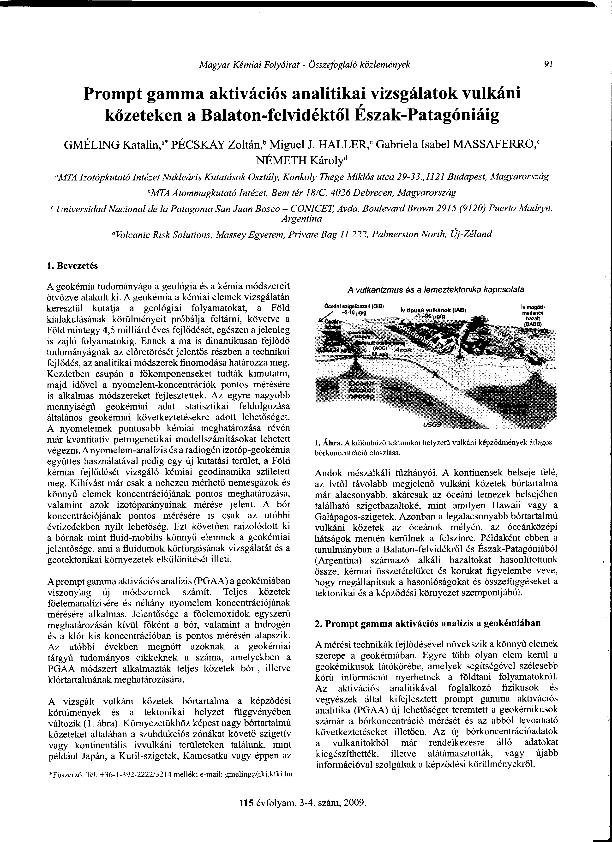Artículo
The importance of the light elements in geochemistry has been growing because the analytical techniques for measuring them went through a great improvement. Boron is an incompatible and fluid-mobile element possessing two isotopes with greatly different abundances in nature, and also the abundance of boron greatly differs in different reservoirs. These facts make boron an important tracer of the recycled materials is subduction zones. In the subducting slab most of the boron is concentrated in the oceanic crust and sediments, but most of it leaves the slab close to the suture zone of the subduction. However, some minerals can retain boron and carry it further down into the mantle, even reaching depths of the lower mantle and taking part in deep recycling. The most suitable analytical techniques for B concentration measurements, is a non-destructive nuclear method of prompt gamma activation analysis (PGAA). This article resumes conclusions based on the B data measured in volcanic rocks from a back-arc basin setting from the Balaton-Highland and North-Patagonia. We emphasize that the origin of the alkaline basalt magmas in these regions are connected to extension influenced decompression-melting and asthenospheric upwelling. The B/Sm ratio of the examined rocks from Balaton-Highland and Crater Basalt volcanic fields overlap and are higher than those from Rio Genoa. The greater amount of fluid-mobile boron in the alkaline basalts from the Balaton-Highland compared to the North-Patagonian samples, indicate higher value of crustal thinning due to extension in the Pannonian basin. A geokémia tudományága a geológia és a kémia módszereit ötvözve alakult ki. A geokémia a kémiai elemek vizsgálatán keresztül kutatja a geológiai folyamatokat, a Föld kialakulásának körülményeit próbálja feltárni, követve a Föld mintegy 4,5 milliárd éves fejlődését, egészen ajelenleg is zajló folyamatokig. Ennek a ma is dinamikusan fejlődő tudományágnak az előretörését jelentős részben a technikai fejlődés, az analitikai módszerek finomodása határozza meg. Kezdetben csupán a fókomponenseket tudták kimutatni, majd idővel a nyomelem-koncentrációk pontos mérésére is alkalmas módszereket fejlesztettek. Az egyre nagyobb mennyiségű geokémiai adat statisztikai feldolgozása általános geokémiai következtetésekre adott lehetőséget. A nyomelemek pontosabb kémiai meghatározása révén már kvantitatív petrogenetikai modellszámításokat lehetett végezni. A nyomelem-analízis és a radiogén izotóp-geokémia együttes használatával pedig egy új kutatási terület, a Föld kémiai fej lődését vizsgáló kémiai geodinamika született meg. Kihívást már csak a nehezen mérhető nemesgázok és könnyű elemek koncentrációjának pontos meghatározása, valamint azok izotóparányainak mérése jelent. A bór koncentrációjának pontos mérésére is csak az utóbbi évtizedekben nyílt lehetőség. Ezt követően rajzolódott ki a bómak mint fluid-mobilis könnyű elemnek a geokémiai jelentősége, ami a ftuidumok körforgásának vizsgálatát és a geotektonikai környezetek elkülönítését illeti.
Prompt gamma activation analysis on volcanic rocks from the Balaton-Highland to North-Patagonia
Título:
Prompt gamma aktivációs analitikai vizsgálatok vulkáni kőzeteken a Balaton-felvidéktől Észak-Patagóniáig
Gméling, Katalin; Pécskay, Zoltán; Haller, Miguel Jorge F. ; Massaferro, Gabriela Isabel
; Massaferro, Gabriela Isabel ; Németh, Karoly
; Németh, Karoly
 ; Massaferro, Gabriela Isabel
; Massaferro, Gabriela Isabel ; Németh, Karoly
; Németh, Karoly
Fecha de publicación:
12/2009
Editorial:
Hungarian Chemical Society
Revista:
Hungarian Journal of Chemistry
ISSN:
1418-9933
Idioma:
Indeterminado
Tipo de recurso:
Artículo publicado
Clasificación temática:
Resumen
Palabras clave:
BORONCONTENTS
,
VOLCANIC ROCKS
,
PATAGONIA
,
BALATON HIGHLAND
,
HÚNGARO
Archivos asociados
Licencia
Identificadores
Colecciones
Articulos(CCT-CENPAT)
Articulos de CTRO.CIENTIFICO TECNOL.CONICET - CENPAT
Articulos de CTRO.CIENTIFICO TECNOL.CONICET - CENPAT
Citación
Gméling, Katalin; Pécskay, Zoltán; Haller, Miguel Jorge F.; Massaferro, Gabriela Isabel; Németh, Karoly; Prompt gamma activation analysis on volcanic rocks from the Balaton-Highland to North-Patagonia; Hungarian Chemical Society; Hungarian Journal of Chemistry; 115; 3-4; 12-2009; 91-97
Compartir



